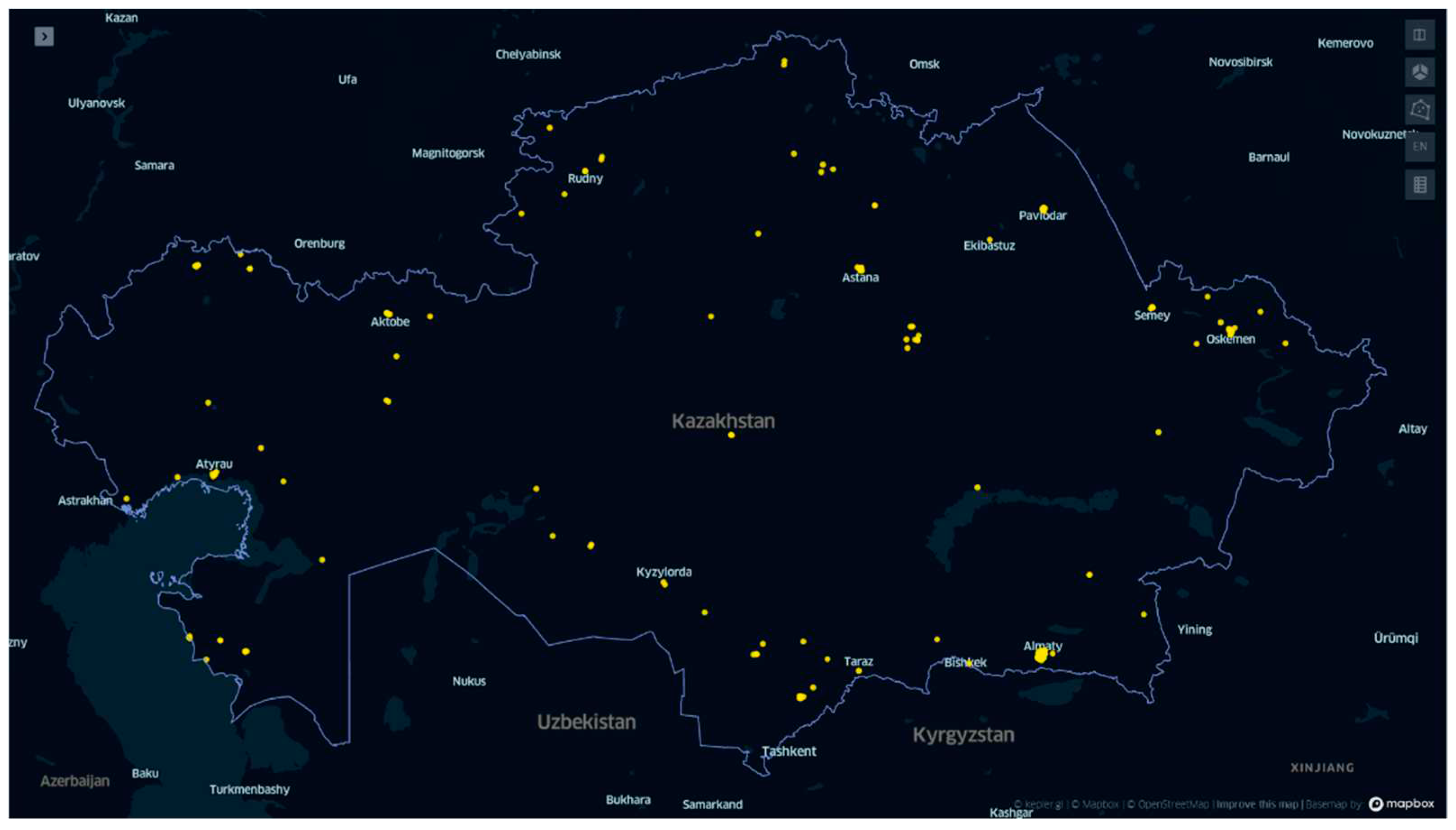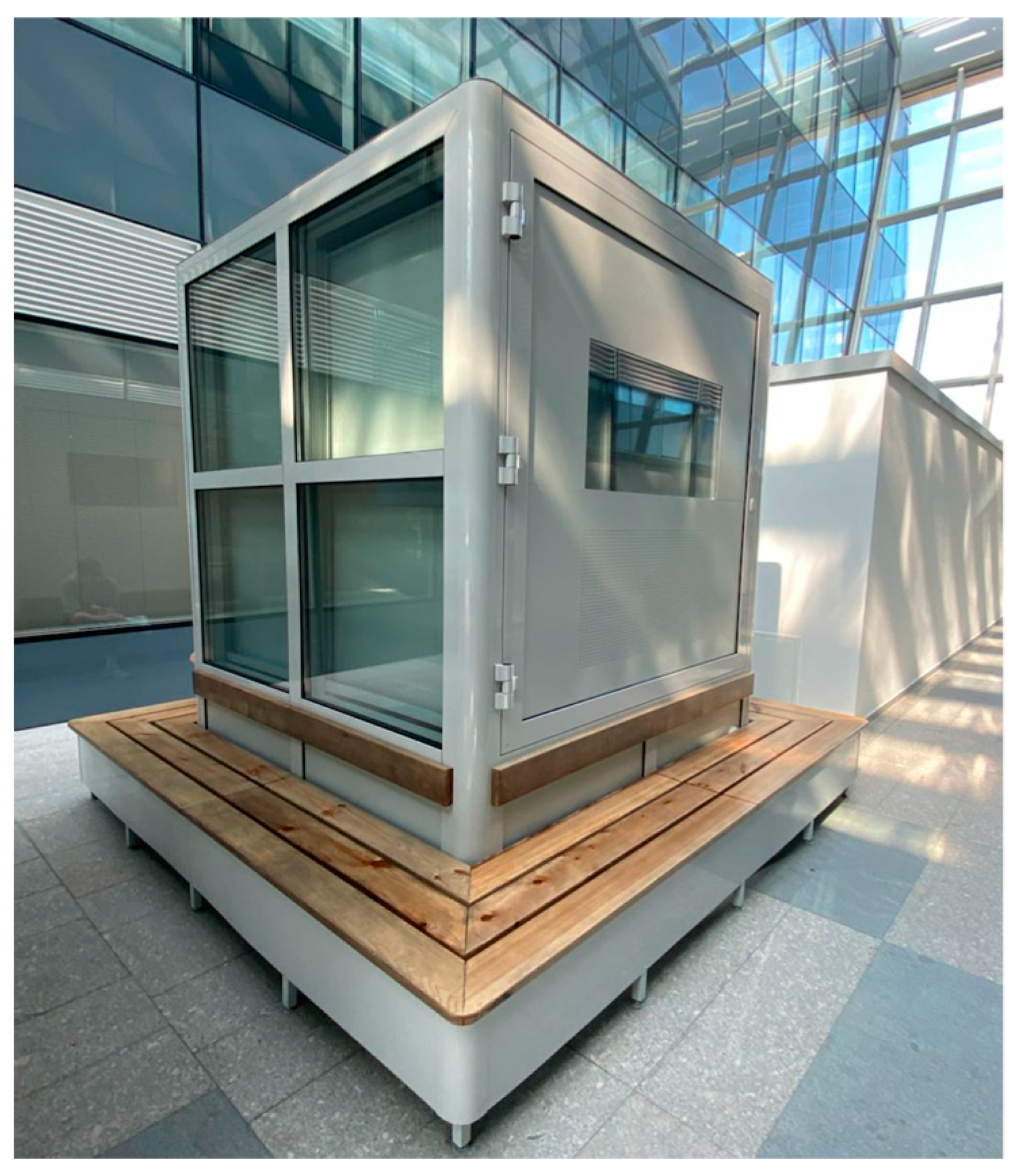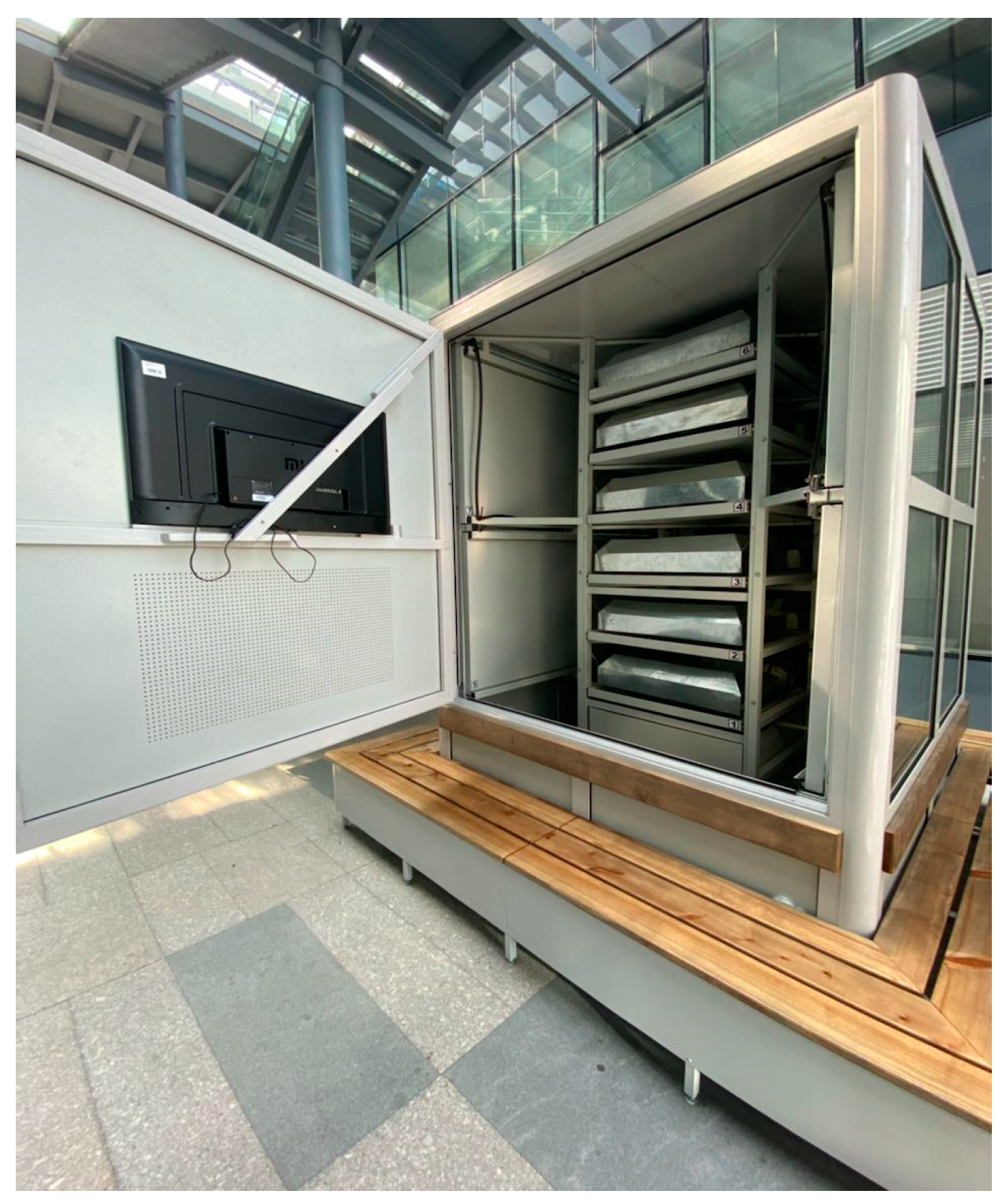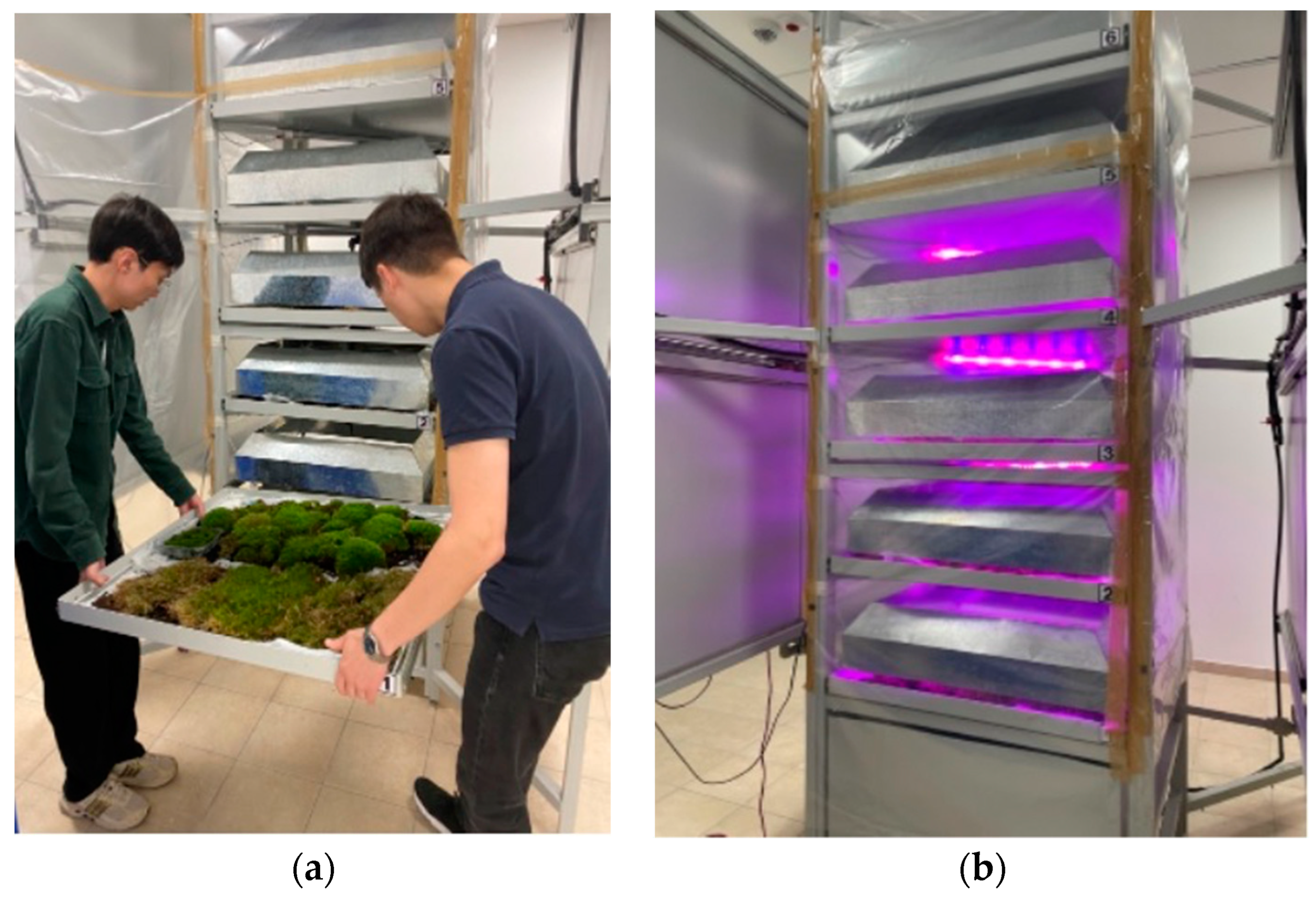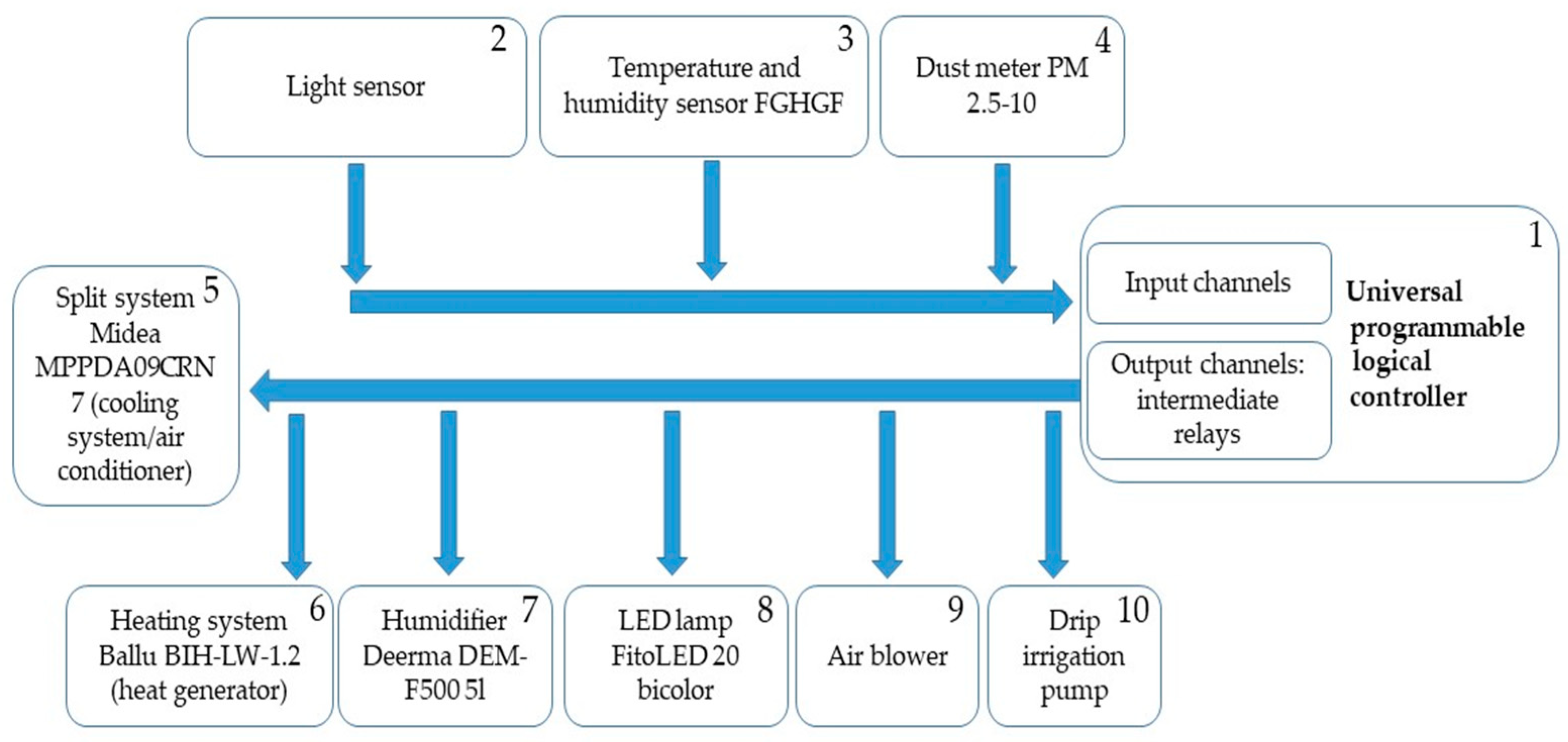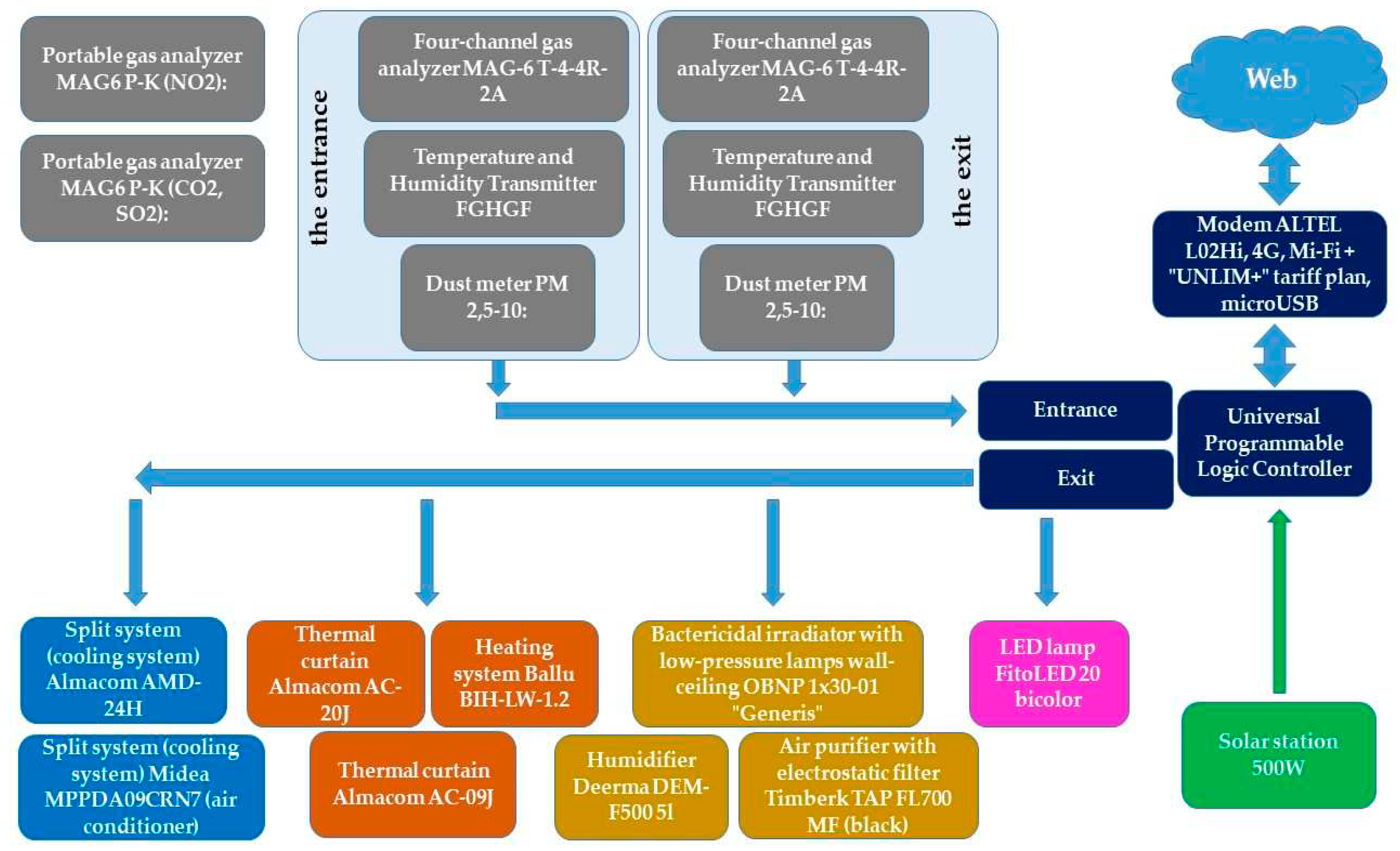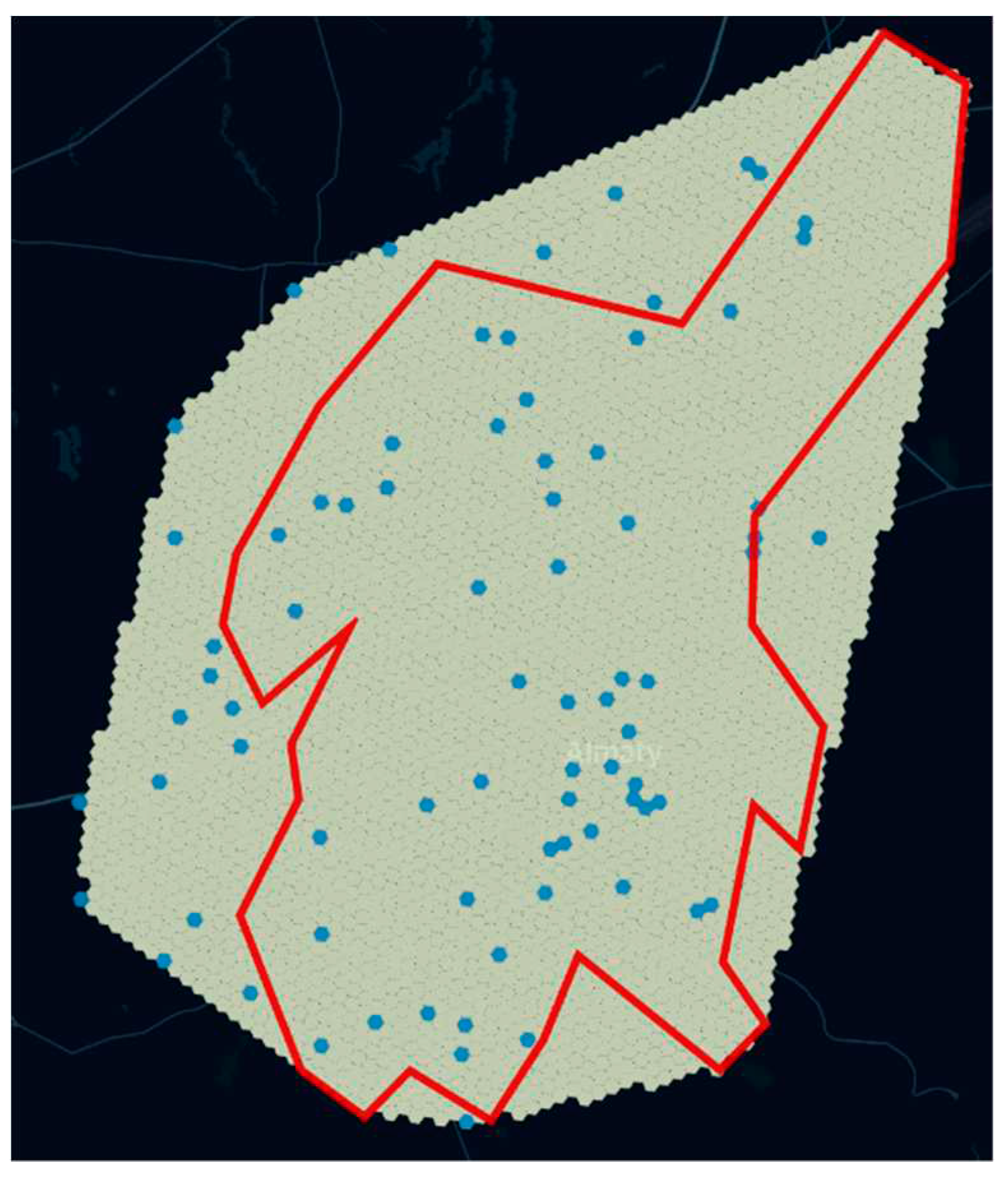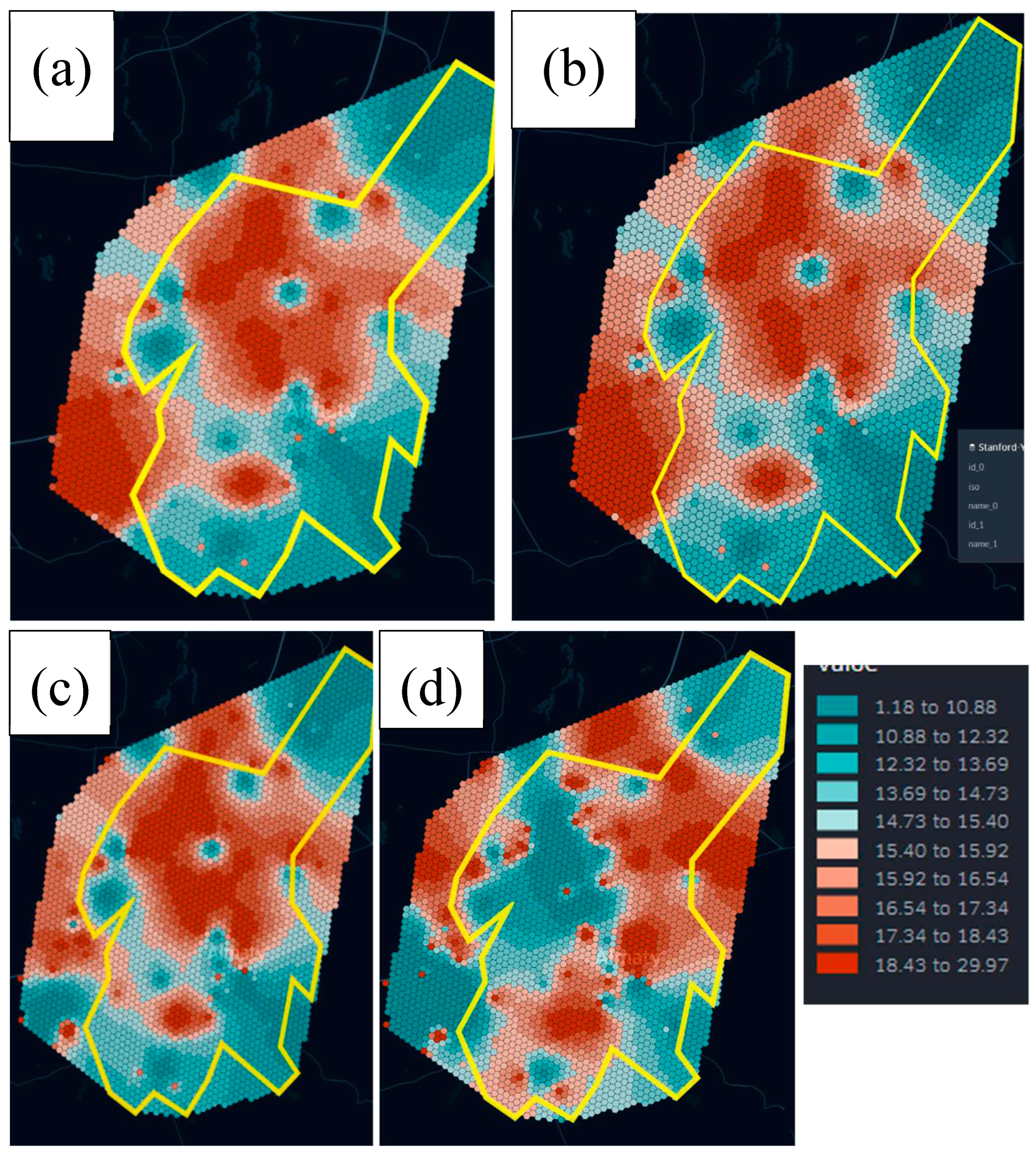1. Introduction
The problem of air pollution is one of the main issues posing a severe threat to the health of millions of people. In 2021, the World Health Organization (WHO) estimated that more than 7 million deaths were caused by air pollution [
1]. The air pollution problem is particularly acute in large cities, especially those with active industrial facilities and cities with specific geographical locations that complicate natural air purification. Air pollution not only affects people's health but also significantly worsens the overall quality of life. Both natural and anthropogenic air pollutants can spread over considerable distances and cover large areas through wet and dry precipitation. This poses a severe risk to human health, as these pollutants can be inhaled or enter the food chain. Significant health effects are associated with both short-term and long-term exposure to air pollution. Consequently, air quality monitoring and the implementation of engineering solutions for air purification are essential tasks in the field of urban science.
The International Organization for Standardization (ISO) Technical Committee for the Sustainable Development of Communities is developing a new series of international standards for an integrated approach to sustainable development [
2]. The International Standard ISO 37120:2018 Sustainable Cities and Communities—Indicators for city services and quality of life [
3] (second edition: 2018; first edition: 2014). It includes many factors influencing the quality of life such as economic factors, education, energy, urban planning, etc. These factors make it possible to measure the quality of life, establish the efficiency of city services, and ensure effective urban planning of rapidly growing cities. In work [
4], based on the ISO 37120:2018 standard, seven dimensions were developed for evaluating urban quality of life. These include urban services, economy, culture and recreation, urban mobility, conviviality, security, and environmental comfort. The latter include noise and air pollution, climate comfort, cleanliness, and wastewater.
In large cities with well-developed transport infrastructure, the issue of air pollution remains highly relevant. The development of engineering solutions to address this problem is directed towards enhancing the city's sustainability amidst rapid population growth, improving the ecological conditions within the urban environment, and enhancing overall quality of life. The establishment of systematic approaches for monitoring air pollution levels and formulating long-term strategies to enhance air quality are imperative objectives in urban development. Achieving success in these tasks results in decreased health risks for citizens, subsequently leading to reduced burdens on city and state budgets for medical care expenses.
The dispersion of different air pollutants follows a non-linear pattern, exhibiting varied concentrations in different regions. Consequently, it becomes crucial to forecast fluctuations in air pollutant levels and devise engineering solutions to address this challenge. The issue of air pollution holds particular significance for prominent cities and their rapidly expanding agglomerations. A notable example is the city of Astana, the capital of the Republic of Kazakhstan, with a metropolitan population exceeding 1.3 million people. Astana experiences an annual population growth rate ranging from 3.5% to 4%.
The purpose of this study is to investigate methods for reducing environmental pollutants in the Republic of Kazakhstan, specifically by developing and implementing a biotechnological purification filter based on living plants. To achieve this objective, three main problems need to be addressed:
- Description of the engineering solution for creating a biotechnological cleaning filter using moss, considering the unique climatic features of the Republic of Kazakhstan;
- Evaluation of the capacity of moss to absorb heavy metals under natural conditions;
- Assessment of the effectiveness of the biotechnological cleaning filter based on moss, taking into account the prevailing level of air pollution.
By applying urban science methodologies to devise engineering solutions that foster a comfortable living environment, cities can become eco-friendlier and more sustainable.
2. Literature review
Air pollution presents a multifaceted and intricate challenge, demanding comprehensive solutions. It is imperative to adopt a multifaceted approach that includes monitoring and forecasting air pollution levels across different areas of the city. This facilitates the analysis of pollution sources and enables the proposal of corrective actions to local authorities. Simultaneously, the establishment of air quality standards and systematic assessment and management measures are vital components of an effective solution. The development of a long-term strategy to ensure citywide air quality is an integral part of urban science. Large cities, characterized by dense populations and increased health risks, face particularly acute air pollution issues. Currently, more than 50% of the global population resides in urban areas. A noteworthy study [
5] explores the correlation between air pollution and the risk of emergency care for young children with asthma. Such research emphasizes the criticality of air purification efforts in ensuring the high quality and safety of people's lives.
A current trend in addressing air purification challenges involves the development of biotechnological filter systems utilizing specific plant crops capable of removing pollutants while releasing oxygen. This approach has gained traction, with relevant projects securing government funding in countries such as Great Britain, Germany, Portugal, and the Republic of Kazakhstan [
6]. These filters offer the advantage of flexibility in placement, as they can be deployed in various locations within the city. However, their cost remains a hindrance, and establishing mass production is yet to be achieved. Consequently, it becomes crucial to employ these filters judiciously, situating them solely in areas where their necessity is warranted. In [
7], a model was constructed to identify the optimal placement of biotechnological filter systems for air purification by addressing the discrete optimization problem. This model considers the forecast of the air quality index for a specific region, ensuring efficient deployment of these biotechnological systems for improved air quality.
Various engineering solutions are being developed for this purpose. For example, the concept of the CityTree vertical plant filter is described in [
8]. It comprises a vertical plant structure that not only cleans the air but also cools the environment, retains water, and reduces noise. According to the findings in [
6], the innovative CityTree device effectively reduces air pollution from harmful solid particles and gases, including NO2 and CO2. Remarkably, one such device can replace the equivalent of 275 trees, while requiring minimal urban area for placement. However, the application of such filters in the conditions of Kazakhstan poses challenges due to its predominantly continental climate zone. Astana, in particular, ranks as the second coldest capital city globally. Consequently, utilizing open purification biotechnological filters in these conditions proves ineffective, as plants necessitate maintaining stable temperatures and humidity throughout the growing season.
Moss is an intriguing plant known for its capacity to achieve a high level of air purification, particularly under conditions of stable temperature and humidity. The paper [
9] outlines a moss biomonitoring method utilizing three moss types: Pleurozium schreberi, Sphagnum fallax, and Dicranum polysetum. This method involves measuring the concentration of analytes (Mn, Fe, Cu, Zn, Cd, Hg, and Pb) accumulated within the total suspended particulate matter collected from dust collector filters in Opole (Opole Voivodeship, Poland). Engineering solutions for developing a moss-based air purification system are described in works [
10,
11]. These works detail a biotechnological prototype capable of automated control over moss growth and productivity. As a result, stable air purification efficiency is ensured once the filter is installed. However, to evaluate the filter's effectiveness, it becomes necessary to collect enough data from air quality monitoring sensors both before and after the filter's installation, while also accounting for the costs of ensuring the uninterrupted operation of the filter and other relevant factors.
An essential component of the filter's effective operation is the provision of constant air quality monitoring. In [
12], researchers developed combined models for forecasting air pollution within an intelligent air purification system. These models can be utilized for environmental monitoring, particularly as part of hardware and software solutions. As demonstrated in the study [
13], air pollutants in the city exhibit uneven distribution in both space and time. Consequently, certain regions experience regular exceedance of permissible pollutant concentrations, posing health risks to city dwellers. In [
14], researchers constructed a multi-criteria model for the optimal placement of green areas in the city based on demographic indicators. However, this model does not account for the dynamics of city development. In contrast, the study [
15] formulated a multi-criteria placement optimization model aimed at maximizing air purification while minimizing heating of street surfaces. This proposed model enables the selection of the most suitable option from the predefined plans for green area locations. The outcomes of solving these problems can contribute to the optimal placement of biotechnological filters throughout the city.
The city of Astana, serving as the capital of the Republic of Kazakhstan, sustains a substantial population of over 1.3 million individuals. As of 2023, it is expected to maintain a moderate level of air quality, denoted by an AQI (Air Quality Index) of 53. During the period from June 14 to July 14, 2023, the average air quality level records an AQI of 39 [
16], aligning with the latest WHO air quality guidelines [
17]. The principal sources of urban air pollution in Astana encompass stationary thermal power plants, boiler houses, vehicular emissions, construction sites, production facilities, cement, and asphalt factories. Past data indicates a declining trend in pollutants emanating from stationary sources in the city [
18]. However, this trend remains vulnerable to rapid changes due to the city's burgeoning growth, a continuous increase in the number of vehicles, and the presence and use of older car models whose emissions surpass acceptable environmental safety levels. Furthermore, the air quality in Astana experiences significant deterioration when the air temperature drops, particularly during the onset of winter and periods of low wind speed, as these conditions foster the accumulation of small polluting particles.
The tendency of air quality deterioration is a recurring issue observed in certain regions of Kazakhstan, notably in the largest city, Almaty, situated in the southern part of the country. Almaty exhibits PM2.5 concentration levels 1.5 times higher than the WHO's annual air quality guideline value [
19], largely attributed to the city's specific geographical location. Resolving this complex environmental situation necessitates engineering solutions, particularly the development of specialized filters designed to enhance air quality.
To address air quality concerns, Kazakhstan has implemented systemic measures at both the state and local levels. For instance, in accordance with the Paris Agreement on climate change, the Republic of Kazakhstan aims to reduce carbon dioxide emissions by 45 percent by 2030 and achieve zero emissions by 2050. As part of this commitment, Astana plans to gradually replace all public transport with electric buses. Additionally, efforts have been made to restrict large-sized vehicles and heavy-duty equipment in the central part of the city, alongside the establishment of a transparent permit system. Moreover, periodic inspections ensure compliance with environmental requirements when using vehicles. As a pressing objective, the development of a biotechnological filter specifically tailored to effectively purify the air in a particular region is underway. A key aspect of the research involves evaluating the efficiency of such filters in removing specific pollutants from the air.
3. Materials and Methods
3.1. Basic Concepts creation of a moss-based biotechnological purification filter, taking into account the climatic features of the Republic of Kazakhstan
An essential consideration in the development of a biotechnological purification filter based on moss for installation in Kazakhstan's conditions is the country's predominant location in the continental climate zone. In such climatic conditions, many plants struggle to survive. Consequently, it becomes imperative to create a closed system to ensure the effective operation of the filter.
The following technical characteristics were used during construction works of the biotechnological filter:
1. Frame size: 2.8 meters (height) * 2 meters (width) * 2 meters (length).
2. The entire frame structure is made partially collapsible and convenient for transportation. Effective thermal insulation is provided within the standards to avoid heat losses in the structure. The frame is resistant to strong winds, which are observed in most of Kazakhstan during a certain period of the year. The metal structure of the frame of the biotechnological filter is made of non-corrosive materials. All connections are tested for strength and tightness.
3. In the manufacture of the external frame (front and side), profiles, and corner connectors, aluminum was used as the primary material, namely aluminum sheet 2 mm "Alkan" and aluminum partitions, assembled and painted with polymer paint (color RAL 7035).
4. The upper and lower parts of the filter are made of sheet metal with a thickness of at least 2 mm. The upper and lower parts are insulated with special extruded insulation with a thickness of at least 40 mm. Crossbar reinforcement is provided for installing solar panels on the upper part. The crossbars are installed every 50 cm. In the lower part, there is a hole for connecting communications.
5. The front sides are made of energy-efficient double-glazed windows filled with argon using tempered glass on all sides, divided into four parts, and made of aluminum profiles. Glass thickness of at least 4 mm.
6. The sides include a cavity for installing a demo screen (43-inch monitor) covered by protective glass. The slot for the monitor is insulated and does not allow cold and wind to pass through. Under the monitor, through-holes are provided to organize controlled entry and exit of air from two sides. The side is removable to allow system maintenance and plant access.
7. The inner part of the frame provides racks measuring 1 meter * 1 meter to install and fasten filter components. A bench around the 360-degree biotech filter, at least 45 centimeters high and at least 45 centimeters deep, made of wood. The design of the bench is mobile.
After the construction work is completed, the appearance of the biotechnological filter looks as shown in
Figure 1.
Figure 2 shows a biotechnological system in the middle of the filter. The installation consists of eight vertical trays on two opposite sides, four on each. The size of the vertical tray is 95x90 cm. Six horizontal trays are installed between the vertical trays. The size of the horizontal tray is 80x80 cm. The trays are made of stainless material and painted with polymer paint. The total height of the farm is 270 cm, and the occupied area is 3.24 m2. The culture is placed in trays on top of the selected substrate. A net is used to fix the moss and substrate during vertical cultivation.
A reservoir is installed under the horizontal trays to irrigate the culture. The volume of the tank is 0.32 m3. A water sprinkler is installed above each horizontal tray. Galvanized sheets are mounted around the tray's perimeter to insulate against water splashes. When growing moss vertically, holes for the irrigation of crops are provided above each tray. Water is supplied to the sprayer using a pump. Trays, both vertical and horizontal, slide out for convenient operation. All conditions (water rate, humidity, temperature, lighting) for crop cultivation are controlled using a controller and a minicomputer.
Figure 3a,b show an experimental setup of moss trays at a biotech filter farm.
A set of FGHGF sensors with a maximum measurement temperature of 49 degrees Celsius is used to monitor temperature and humidity in the filter. A MAG-6 gas analyzer is used for air quality analysis.
3.2. Automated microclimate support system in a biotechnological air purification filter
In
Figure 4, the universal programmable logic controller 1 has input and output channels connected to intermediate relays. In turn, the light sensor 2, air temperature and humidity sensor 3, sawdust meter PM 2.5-10 4 are connected to the input channels of the controller 1, the output channels of which are connected through intermediate relays to the cooling system/air conditioner 5, the heat generator/heating system 6, the air humidifier seven and the LED lamp 8, the air pumping fan nine and the drip irrigation pump 10. As a programmable log controller 1, a universal controller based on Cortex A57 can be used, as a light sensor 2 - GY-30 (BH1750FVI, I2C), as a temperature and humidity sensor 3 - Temperature and Humidity Transmitter FGHGF, as a sawdust meter 4 - PMS5003 high-precision laser sensor pm2.5, as a cooling/conditioning system 5 - Midea MPPDA09CRN7, as a heat generator 6 - Ballu B heating system IH-LW-1.2, as a humidifier 7 - Deerma DEM-F500, as lighting lamps 8 FitoLED 20 bicolor, as an air pumping fan 9 - channel fan with three speeds, drip irrigation pump 10 - Magnetta 1AWZB550.
The conceptual model of data exchange and management of the biotechnological filter is presented in
Figure 5.
The universal programmable logic controller 1 is installed inside the biotechnological filter and connected to the power supply. After switching on, controller 1 turns on the air pumping fan 9 through the filter with the specified rotation frequency n and interrogates the light sensor 2, air temperature and humidity sensor 3, and PM 2.5-10 dust meter 4 connected through the input channels. After interrogating and receiving data from the sensors, the controller compares with the programmed values of the settings and values of the parameters necessary to support the necessary microclimate inside the biotechnological filter. When the polled value from the sensors is different from the set value of the parameter, controller 1 gives a command to the output channels through the intermediate relays to turn on or off the connected cooling/air conditioning system 5, heat generator/heating system 6, air humidifier 7 and LED lamp 8. After an interval, it polls the data from the sensors again and, if necessary, exerts a control effect through the intermediate relays. After a specific interval of t2, the drip irrigation pump is turned on. It is impossible to maintain the parameters of temperature, humidity, and dust inside the biotechnological filter at the initial fan rotation speed of 9 n. In that case, the controller reduces the speed by the value m. After a specific time, interval t3, controller 1 sends a signal to turn on pump 10 for watering the integrated moss modules. Thus, inside the biotechnological filter, constant parameters of the necessary microclimate are maintained for the functioning of integrated moss modules, the task of which is air purification.
4. Results
4.1. Collection of Data
As the biotechnological filter entails considerable expenses, a prudent approach is crucial in selecting appropriate locations for their placement within the city. The filters should be strategically positioned where they can exert a significant impact on air purification. To identify the most rational points for filter placement, a network of 220 sensors was considered across 73 cities within the Republic of Kazakhstan (
Figure 6).
Table 1 provides a breakdown of the number of sensors in the selected cities. In the remaining cities of Kazakhstan, four or fewer sensors have been installed. Detailed information on the location of the sensors can be found in
supplementary materials 1. The most significant number of sensors are installed in Almaty because this city traditionally observes an excess of pollution indicators. This is primarily due to the city's geographical location and dense population.
The sensors record the content of CO, H2S, NO, NO2, SO2, dust in general, and PM
2.5 and PM
10 in the air every hour. Indicators were collected hourly for the period from 06/21/2020 to 06/04/2023. The sensors do not have the means to detect the concentration of heavy metals in the air. However, based on research [
20], the concentration of heavy metals was estimated based on the amount of PM
2.5 and the corresponding coefficients, which are listed in
Table 2.
Table 2.
Coefficients for conversion of PM2.5 concentration into corresponding metal concentrations.
Table 2.
Coefficients for conversion of PM2.5 concentration into corresponding metal concentrations.
| |
Coefficients, μг/mg |
| Pb |
Cd |
Zn |
Cu |
Fe |
Ni |
Co |
Mn |
Cr |
| Min |
0,07 |
0,01 |
0,20 |
0,02 |
0,86 |
0,07 |
0,01 |
0,01 |
0,04 |
| Max |
0,30 |
0,01 |
0,75 |
0,14 |
2,02 |
0,30 |
0,01 |
0,01 |
0,12 |
| Average |
0,17 |
0,01 |
0,45 |
0,05 |
1,50 |
0,17 |
0,01 |
0,01 |
0,08 |
Figure 6.
Location of air pollution monitoring stations in the Republic of Kazakhstan (made using the Kepler service).
Figure 6.
Location of air pollution monitoring stations in the Republic of Kazakhstan (made using the Kepler service).
As a result of data collection, 1760 time series were obtained, totaling 12,785,943 points. Detailed sensor data can be found in
Supplementary materials 2.
4.2. Evaluation of the degree of absorption of heavy metals by moss in a biotechnological purification filter
Solving the task of creating optimal conditions for the growth of plants responsible for air purification is an integral component of a biotechnological cleaning filter. For this study's prototype of the biotechnological filter, a plant - moss (in the taxonomic division Bryophyta), in particular, Sphagnopsida, was chosen.
Sphagnopsida helps solve the problems of biomonitoring of environmental pollution and CO2-neutral agriculture to combat climate change [
21]. The systematic moisture provision is a mandatory condition for growing Sphagnopsida, as it cannot actively control the water supply system [
22]. Sphagnum can absorb an amount of water that exceeds 20 times its weight. Sphagnum has no roots or rhizoids. Only the upper part grows, and stems are formed. The lower part of the stems dies and transforms into peat. Most species of sphagnum are adapted to low light [
23].
During the study, the temperature regime for sphagnum was found to be 3-22 °C in vivo or 10-20 °C in vitro. During the day, the optimal air temperature for growing sphagnum in a closed system is 22±1°C. At night 16±1°C, the light period is 16 hours, and the relative humidity is 85±15%.
From September 28 to October 5, 2022, an experiment was conducted to determine the air quality for the presence of heavy metals in the city of Astana (Republic of Kazakhstan). Sphagnum moss bags were suspended on the 2nd floor of the residential complex (position 1) and in the biofilter (position 2) to determine the degree of accumulation of heavy metals. The air temperature during the experiment for position 1 averaged 20-21 degrees Celsius, and humidity - 54-58%. The results are given in the
Table 3.
According to the results of the experiment, it can be concluded that the Sphagnopsida moss absorbs heavy metals so that it can be used as the basis of biotechnological purification filters.
4.3. Evaluation of the efficiency of the biotechnological cleaning filter based on moss, taking into account the level of air pollution
The task of evaluating the effectiveness of the biotechnological cleaning filter based on moss, considering the level of air pollution, is divided into two subtasks. The first subtask is to maintain stable conditions in the filter. Maintaining a stable temperature and air humidity in the middle of the filter is essential. This is necessary for growing moss, the main component of air purification. A control model was used, described in more detail in the study [
11].
Figure 7 shows a conceptual model of the system functioning for monitoring stable conditions in the middle of the filter. This model contains vector s, which describes the parameters essential for the functioning of the filter. These parameters include air temperature, humidity, and pollution, characterized by the concentration of harmful substances in the air. Also, the state vector includes time.
The function R(s) determines the state of the environment in the location where the biotechnological purification filter based on moss is functioning. The function R(s) value can be calculated based on the data collected during air condition monitoring.
The control function C(s) determines the actions to be taken before the supply air is supplied to the moss chamber in the middle of the filter. As a result of such preparation, the temperature and humidity of the air change. Work [
11] shows that the function C(s) can be found using equation (1).
Calculating the control function is one of the tasks solved with the help of software that supports the operation of the biotechnological filter.
Function G(s) determines the performance of a biotechnological purification filter based on moss. The main expected result is a decrease in the concentration of pollutants in the air due to their absorption by moss. A linear approximation for the function can be calculated based on the research conducted.
where Г is the transformation matrix, the coefficients of which are calculated empirically. In further studies, we will assume that this matrix is diagonal for simplification. That is, the absorption of each pollutant depends only on its concentration and does not depend on other parameters.
The function Y(s) determines the parameters of the air coming from the biotechnological purification filter to the environment.
The second subtask consists in evaluating the effect of filter placement. In order to solve this sub-problem, a spatial model was built to assess the impact of the placement of biotechnological filters on air quality. Considering the collected data of air quality monitoring in the Republic of Kazakhstan, the construction of the model was carried out for the city about which the maximum amount of data is known, namely the city of Almaty. The task of optimal placement of filters is described in [
7].
The spatial model for assessing the impact of the placement of biotechnological filters on air quality contains several simplifications. In particular, the city is covered with a hexagonal grid. The state of the air parameters is assumed to be the same for the entire sub-region bound by the hexagon. Given that the air condition is known only for some subregions, the air condition in other subregions is calculated as the arithmetic average of the air conditions of neighboring subregions. Let a hexagonal grid with n hexagons cover the city, O=(o
1, o
2, …, o
n). Then
,
is the state of the air in the subregion bounded by the hexagon o
i. Let's mark all neighboring hexagons to the hexagon o
i as (
oi+1,
oi+2, …,
oi+m),
,
,
. Then, the state of the air in the hexagon
defined as:
This method of assessing the air's condition is applied to cells lacking air pollution level sensors. In this research, the efficacy of biotechnological filters for air purification in urban areas is evaluated, considering their quantity based on the size of the hexagonal grid cells. The utilization of such a model result in a system of large-scale linear algebraic equations characterized by a highly sparse matrix. The number of unknowns in the system corresponds to the number of subregions, and the number of coefficients different from zero in each row does not exceed 7. The model assumes the installation of one biotechnological purification filter in specific subregions. For simulation simplicity, we consider all biotechnological purification filters to be identical, operating continuously, and exerting a linear influence on the air condition within the subregion.
The city of Almaty was divided into a grid comprising 3447 hexagons (
Figure 8). Within the city, 80 sensors were strategically placed to monitor the level of air pollution, and these sensors collected air condition data from 06/21/2020 to 06/04/2023. Prior to the installation of biotechnological filters based on moss, the air quality within the city was simulated. The air condition in 80 subregions, delineated by the corresponding hexagons, was determined using data from the installed sensors. For the remaining 3367 subregions, the air conditioning was computed using formula (3). This process entailed hourly calculations for the specified period.
Figure 9 presents a map illustrating the average pollution levels in Almaty.
To assess the effectiveness of air purification using filters, an incremental approach was adopted, wherein one filter, two filters, and so forth, were placed in the most polluted regions. For each scenario, air quality indicators were computed using a spatial model.
Descriptive characteristics pertaining to pollution were then derived from the spatial model, enabling a comparison of the effects before and after the installation of filters. The concentration of heavy metals was determined based on the concentration of PM2.5, employing coefficients specified in
Table 2. As a result, the model provided proportional indicators for all heavy metals. Subsequent calculations focused solely on one specific contaminant, namely lead (Pb).
The calculations assumed that one biotechnological purification filter contains 100 kg of Sphagnopsida moss, which, according to
Table 3, absorbs 300 mg of lead every week. The calculation of efficiency from placing a certain number of filters is based on comparing the difference with the pollution of the model without filters. Maximum difference, mean difference, and relative efficiency were calculated. The results are shown in
Table 4.
5. Discussion
5.1. Findings
The simulation results reveal that the application of this air purification concept in the city requires careful consideration of the number of filters needed to achieve the desired cleaning effect. However, given the expensive nature of the filters, it becomes imperative to allocate suitable locations for their installation. Completely cleaning the city from all pollutants would necessitate tens of thousands of installed filters, which is impractical. Moreover, an increase in the number of filters may disrupt the linearity of pollutant absorption, rendering the model inadequate in describing the purification process. Therefore, achieving a high level of urban quality of life demands a comprehensive approach to environmental cleanliness.
The obtained results enable the strategic planning of filter placement and the determination of their required quantity to achieve sufficient air purification in the city. Consequently, it becomes possible to effectively address pollution levels in the city, aligning them with the air quality guidelines set forth by WHO.
5.2. Limitations and future research lines
Assumptions and simplifications were employed during the modeling process. Notably, the absorption of pollution by moss was assumed to occur linearly. However, work [
9] has suggested that the absorption of polluting substances by moss generally follows a non-linear pattern. The model calculated the spread of pollution, assuming that in neighboring subregions defined by a hexagonal grid, pollution levels would be averaged. It is essential to recognize that the dispersion of environmental pollutants is a complex process influenced by various factors, including geography, wind direction, air humidity, and more [
24].
Future research aims to establish the long-term ecological impact in Kazakhstan's cities, along with evaluating the economic effects and urban quality of life based on survey data from residents and quantitative indicators of air quality.
In this study, the placement of one filter in each hexagon of the grid was considered. However, it is necessary to explore options such as combining filters or placing multiple filters in hexagons with high levels of air pollution to ensure enhanced air purification efficiency.
The simulation involved calculating the effect of placing more than 800 filters in Almaty. As the number of filters increased, some hexagons displayed negative pollutant concentration values. In such cases, it is advisable to develop an alternative model for evaluating the effectiveness of air purification based on biotechnological filters.
Currently, the developed biotechnological filter based on moss is undergoing placement on a street in Astana, outside the university laboratory. Experimental data on the filter's effectiveness in natural conditions will be recorded shortly.
6. Conclusions
The article outlines the development of a biotechnological purification filter based on moss as part of the Smart City concept in Kazakhstan. The engineering solution of the filter for outdoor use is comprehensively described, taking into account the climatic peculiarities of the majority of the Republic of Kazakhstan, especially its continental climate. The core of the biotechnological filter consists of a farm with Sphagnopsida moss, and the system automatically regulates temperature, watering levels, and air humidity to facilitate moss growth. The investigation focused on the absorption capacity of Sphagnopsida moss for heavy metals under various conditions, demonstrating the viability of using this moss for air purification in natural environments. To evaluate the effectiveness of air purification with the biotechnological filter based on moss, modeling was conducted in the city of Almaty, Kazakhstan. This city recorded persistent exceedances of harmful substance concentrations in the air, according to WHO air quality guidelines, spanning almost the entire year. Data collected by sensors scattered throughout the Republic of Kazakhstan from 06/21/2020 to 06/04/2023 were employed as the basis for the efficiency evaluation. A total of 220 sensors were deployed across 73 settlements in Kazakhstan, with 80 sensors dedicated to Almaty. The results demonstrated that ten filters achieved an air purification efficiency of 0.77%, while 100 filters yielded 5.72%, and 500 filters attained 23.11% efficiency.
The design of the biotechnological filter for air purification, based on moss, was executed at Astana IT University, considering the specific climate, pollution distribution, and types prevalent in Kazakhstan. These findings hold significant importance in attaining compliance with the ISO 37120:2018 standard concerning environmental comfort, particularly in the Republic of Kazakhstan.
Since the cost of designing, developing, and installing such biotechnological filters is high, calculating air purification efficiency depending on the number of installed filters is essential for local and state budgets. The obtained research results and the experience of implementing a biotechnological filter based on moss in the conditions of the Republic of Kazakhstan can be applied to the design of similar systems in other countries.
Supplementary Materials
The following supporting information can be downloaded at the website of this paper posted on Preprints.org.
Author Contributions
Conceptualization and methodology, A.B., Y.A., D.Y. and O.K.; software, Y.A.; analysis, O.K., Y.A., A.B., B.A. and D.Y.; coding, Y.A.; writing – original draft preparation, O.K. and Y.A.; writing–review and editing, A.B., S.B., V.V. and. A.N.; visualization Y.A.; project administration, A.B. All authors have read and agreed to the published version of the manuscript.
Funding
This research has been funded by the Committee of Science of the Ministry of Science and Higher Education of the Republic of Kazakhstan (Grant No. BR10965311 "Development of the intelligent information and telecommunication systems for municipal infrastructure: transport, environment, energy, and data analytics in the concept of Smart City").
Data Availability Statement
All data is available in this publication.
Acknowledgments
The authors thank the reviewers and editors for their generous and constructive comments that have improved this paper.
Conflicts of Interest
The authors declare no conflicts of interest.
References
- WHO. Billions of people still breathe unhealthy air: New WHO data. 2022. Available online: https://www.who.int/news/item/04-04-2022-billions-of-people-still-breathe-unhealthy-air-new-who-data (accessed on 10 July 2023).
- UN-Habitat. In World Cities Report 2016—Urbanization and Development: Emerging Futures. Available online: https://unhabitat.org/world-cities-report-2016 (accessed on 19 July 2023).
- International Organization for Standardization (ISO). ISO 37120:2018, Sustainable Cities and Communities—Indicators for City Services and Quality of Life. Available online: https://www.iso.org/standard/68498.html (accessed on 19 July 2023).
- Wesz, J.G.B.; Miron, L.I.G.; Delsante, I.; Tzortzopoulos, P. Urban Quality of Life: A Systematic Literature Review. Urban Sci. 2023, 7, 56. [Google Scholar] [CrossRef]
- To, T.; Zhu, J.; Terebessy, E.; Zhang, K.; Fong, I.; Pinault, L.; Jerrett, M.; Robichaud, A.; Ménard, R.; Donkelaar, A. van; Martin, R. V.; Hystad, P.; Brook, J. R.; Dell, S.; Stieb, D. Does exposure to air pollution increase the risk of acute care in young children with asthma? An Ontario, Canada study. Environmental Research. 2021, 199, 111302. [Google Scholar] [CrossRef]
- Green City Solutions. CityTree: A Pollution Absorbing Innovation with the Power of 275 Trees. Available online: https://urbannext.net/citytree/ (accessed on 19 July 2023).
- Biloshchytskyi, A.; Kuchansky, A.; Andrashko, Y.; Neftissov, A.; Vatskel, V.; Yedilkhan, D.; Herych, M. Building a model for choosing a strategy for reducing air pollution based on data predictive analysis. Eastern-European Journal of Enterprise Technologies. 2022, 117, 23–30. [Google Scholar] [CrossRef]
- Saenger, P.; Splittgerber, V. The CityTree: A Vertical Plant Filter for Enhanced Temperature Management. Climate Change Management book series (CCM). 2016, 75–86. [CrossRef]
- Swisłowski, P.; Nowak, A.; Wacławek, S.; Ziembik, Z.; Rajfur, M. Is Active Moss Biomonitoring Comparable to Air Filter Standard Sampling? Int. J. Environ. Res. Public Health. 2022, 19, 4706. [Google Scholar] [CrossRef] [PubMed]
- Yedilkhan, D.; Neftissov, A.; Kusdavletov, S. The Concept of an Automated Biotechnological Filter for Air Purification. In Proceedings of the 2022 IEEE European Technology and Engineering Management Summit (E-TEMS), Bilbao, Spain, 2022; pp. 175–178. [Google Scholar]
- Kusdavletov, S.; Sapargali, A.; Yedilkhan, D.; Yermekov, A. Moss-Based Biotechnological Air Purification Control System. In Proceedings of the 2022 International Conference on Electrical and Computing Technologies and Applications (ICECTA), Ras Al Khaimah, United Arab Emirates, 2022; pp. 343–346. [Google Scholar]
- Biloshchytskyi, A.; Kuchanskyi, O.; Andrashko, Y.; Neftissov, A.; Yedilkhan, D.; Vatskel, V. Models and methods for monitoring, air purification, and forecasting environmental pollution. In Proceedings of the 2023 International Conference on Computational Intelligence and Knowledge Economy (ICCIKE), Dubai, United Arab Emirates, 2023; pp. 107–112. [Google Scholar]
- Ung, A.; Wald, L.; Ranchin, T.; Weber, C.; Hirsch, J.; Perron, G.; Kleinpeter, J. Satellite data for the air pollution mapping over a city – The use of virtual stations. In Proceedings of the 21th EARSeL Symposium, Observing our environment from space: New solutions for a new millenium, Paris, France,, 14–16 May 2001; Tokyo. 2002. pp. 147–151. [Google Scholar]
- Nyelele, C.; Kroll, C. N. A multi-objective decision support framework to prioritize tree planting locations in urban areas. Landscape and Urban Planning. 2021, 214, 104172. [Google Scholar] [CrossRef]
- Yoon, E.J.; Kim, B.; Lee, D.K. Multi-objective planning model for urban greening based on optimization algorithms. Urban Forestry & Urban Greening 2019, 40, 183–194. [Google Scholar] [CrossRef]
- IQAir. Air quality in Astana. Available online: https://www.iqair.com/us/kazakhstan/astana (accessed on 19 July 2023).
- IQAir. New WHO air quality guidelines will save lives. Available online: https://www.iqair.com/us/newsroom/2021-WHO-air-quality-guidelines (accessed on 19 July 2023).
- Kerimray, A.; Bakdolotov, A.; Sarbassov, Ye.; Inglezakis, V.; Poulopoulos, S. Air pollution in Astana: Analysis of recent trends and air quality monitoring system. 5th International Conference on Nanomaterials and Advanced Energy Storage Systems, INESS 2017 - Astana, Kazakhstan. 2018, 5, 11, 22749–22458.
- IQAir. Air quality in Almaty. Available online: https://www.iqair.com/us/kazakhstan/almaty-qalasy/almaty (accessed on 19 July 2023).
- Zhao, P. S.; Dong, F.; He, D.; Zhao, X. J.; Zhang, X. L.; Zhang, W. Z.; Yao, Q.; Liu, H. Y. Characteristics of concentrations and chemical compositions for PM 2.5 in the region of Beijing, Tianjin, and Hebei, China. Atmospheric Chemistry and Physics. 2013, 13, 4631–4644. [Google Scholar] [CrossRef]
- Decker, E. L.; Reski, R. Mosses in biotechnology. Current opinion in biotechnology. 2020, 61, 21–27. [Google Scholar] [CrossRef]
- McCarter, C. P. R.; Price, J. S. Ecohydrology of Sphagnum moss hummocks: Mechanisms of capitula water supply and simulated effects of evaporation. Ecohydrology. 2014, 7, 33–44. [Google Scholar] [CrossRef]
- Harley, P. C.; Tenhunen, K. J.; Murray, K. J.; Beyers, J. Irradiance and temperature effects on photosynthesis of tussock tundra Sphagnum mosses from the foothills of the Philip Smith Mountains, Alaska. Oecologia. 1989, 79, 251–259. [Google Scholar] [CrossRef] [PubMed]
- Daly, A.; Zannetti, P. Air pollution modeling–An overview. Ambient air pollution 2007, 15–28. [Google Scholar]
|
Disclaimer/Publisher’s Note: The statements, opinions and data contained in all publications are solely those of the individual author(s) and contributor(s) and not of MDPI and/or the editor(s). MDPI and/or the editor(s) disclaim responsibility for any injury to people or property resulting from any ideas, methods, instructions or products referred to in the content. |
© 2023 by the authors. Licensee MDPI, Basel, Switzerland. This article is an open access article distributed under the terms and conditions of the Creative Commons Attribution (CC BY) license (http://creativecommons.org/licenses/by/4.0/).
